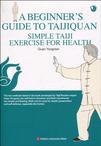简易太极拳养生法
出版时间:2009-1 出版社:外文 作者:关永年 编 页数:75
前言
The Taiji Internal-power Arts, aimed to maintain or improve physi-cal health, combines Taiji exercises, the theories of Yin and Yangand the Five Elements, and TCM (traditional Chinese medicine)meridian theory, drawing strength widely from various exercise formsof the Internal School of Taijiquan, a discipline that emphasizesinner work and strength. Therefore, this form of Taijiquan can helpto remove obstructions in meridians and collaterals, and regulateqi (the flow of energy) and blood circulation. This will help to regu-late the functions of the human body, adjust internal imbalances,achieve peace of mind, and cure illness. At the same time, it alsoadapts the defensive art of “borrowing an opponent's force” foundin the Internal School of Taijiquan.
内容概要
This book deals with the 13-Step Taiji Exercise for Health and the Ten Movements of Taiji Roushu for Fitness. The l 3-Step Taiji Exercise for Health is a simplified form of the 248-Step Taiji Internal-power Exercise for Health, This simplified approach uses fewer movements, and is thus well-suited to beginners. The ten forms of fitness-related Taijiquan, integrating meditation and exercise, were developed by Guan Yongnian on the basis of theTaiji Exercise Manuals' written by Taiji master Zhao Zhongdao who lived to the age of 119. The Ten Movements of Taiji Roushu for Fitness is easy to learn and helps to boost energy and prevent illness.
作者简介
关永年,is a Taiji expert on Roushu(lit. gentle skills), a softer form of Taijiquan aimed to make one relaxed and natural. Born in Beijing in1937, he is of the Manchu ethnic group and is related by marriage to the last Chinese emperor.Mr. Guan began studying wushu as a child and soon acquired the basic skills. He apprenticed himself to Grand Master Zhao Zhongdao, and from him learned the authentic internal-power g skills of Taijiquan. Some years later he developed his own school of Taijiquan, combining the wisdom gained from many other wushu masters and his own years of experience. He has taught thousands of eager practitioners and contin-ued to refine his own understandin of Taijiquan.
书籍目录
Foreword: External Movement and Internal Peace -Health Through Taiji Internal-Power ArtsChapter One 13-Step Taiji Exercise for Health 1. A Simplified Exercise 2. Movements and Illustrations of the 13-Step Taiji Exercise for HealthChapter Two Ten Movements of Taiji Roushu for Fitness Afterword: Key Points for Practice - Tapping into Natural Strengths
章节摘录
插图:Step TwoBelting the RobeContinue from the above step. Shift the body weight slightly tothe left, turn the waist slightly to the left, and turn the right handoutward, palm up. Move the left hand back to beside the righthand, palm down and left fingers forward to the right. Shift thebody weight to the right, turn the waist to the right, and moveboth hands from in front of the left lower abdomen upward to theright; do this in an arc, stopping atthe right shoulder (fig. 4). Turnthe waist further to the right, and move both hands further to theright in an arc to the right side of the body (fig. 5). Turn the waistto the right and then slightly to the left; shift the body weight tothe left leg, bend the left leg, with the body weight entirely on theleft leg, the chest forward to the left, right toes outward to theright. Move the hands to draw a small arc to the right with theright turn of the body and draw them back to before the chest,right palm down (fig. 6).
编辑推荐
《简易太极拳养生法(英文版)》:The two methods listed in the book developed by Taiji Roushu expertGuan Yongnian are well-knit in structure and their movementsare simple and flowing. Both can be used for health preservationand self-defense, especially the former.
图书封面
评论、评分、阅读与下载
用户评论 (总计6条)
- 第二次买了,送给外国客户的。感觉还不错
- 比想象中的薄,也简单,比较适合没有基础的老外~
- 作为礼物送给老外的。中国功夫,他们很喜欢。这本书印刷比较一般,但可贵的是有光盘。起码可以依葫芦画瓢吧。
- 与我们一般看到的陈式太极拳稍有不同,是太极柔术13式,比较简单.讲解得比较详细,一式一式分解讲得, 只是不知道完全没有接触过太极拳的外籍朋友是否看得懂. 附送有光盘, 起码可以照猫画虎, 有全套动作演示也有分步讲解, 遗憾的是都是字幕,如果有配音旁白讲解就更好了.
- 相对书价,内容很少。光盘内容不适合自学,讲解不细,书皮很脏。
- 书的印刷和纸张都很不错,翻译很地道,书不厚但是表达很明晰。国外客人很喜欢
